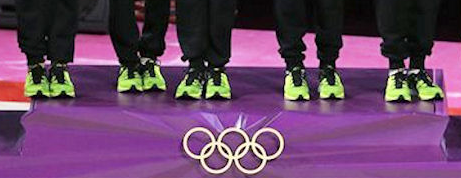As the Olympics wind down to a close, I thought I'd show you the answers I found to a host of little questions that I had about various bits & pieces from different athletic events. It's a medley of Olympic facts!
Diving: What's up with those little towels that the divers carry around all the time?

Christina Loukas drops her shammy down from the diving board during the women's 3M springboard prelims.
(Photo by David Eulitt of the Kansas City Star)

The Sammy towel sells for between $12 and $20 each.
(Photo from Swimx.com)

Great Britain's Tom Daley has a tie-dyed shammy. Here, he's using it to cover his eyes between dives.
(Photo from UK Eurosport)
Diving: What's up with those little towels that the divers carry around all the time?
Christina Loukas drops her shammy down from the diving board during the women's 3M springboard prelims.
(Photo by David Eulitt of the Kansas City Star)
- They're called shammies or sammies.
- Like the chamois (pronounced shammy) towels for drying off your car, they used to be made of actual chamois, which was the skin of a particular goat that lives in Europe and Asia. Towels made of this material were super-absorbent, so they didn't need to be big.
- Now, however, these towels are made of synthetic poly-vinyl materials which are just as absorbent. So instead of calling them by the original French word, they're now called by the way the French word is pronounced: shammy (or shammies, plural).
- Some divers call them Sammies because of this: in 1977, Dr. Sammy Lee was coaching the US diving team at the Swedish cup. A Norwegian diver was using a shammy, and he gave it to Dr. Lee, who passed it on to a member of his team. The team started calling the coach Shammy instead of Sammy. The team member to whom he'd given the towel was none other than Greg Louganis. When Louganis started winning all sorts of medals for his diving, the kind of towel he was using became popular too. When a company in the states started making the towels, Dr. Lee stamped his name Sammy on them, so people called the towels Sammies.
The Sammy towel sells for between $12 and $20 each.
(Photo from Swimx.com)
- The reason this towel is so popular is because divers need their hands to be dry before they execute a dive. This is so, when they clamp their hands around their legs to do a tuck or a spin, their hands won't slip. This would not be a good time for your hands to slip.
- So the divers will bring their shammies / Sammies up onto the board with them, dry off, toss the towel down to the deck, and retrieve it after the dive.
- Since the shammy is pretty much the only thing a diver carries around during a competition, most divers have developed all sorts of rituals around their shammy. They towel off in a certain way, or tie it in a knot, or twirl it, even carry it around with them like a security blanket.

Great Britain's Tom Daley has a tie-dyed shammy. Here, he's using it to cover his eyes between dives.
(Photo from UK Eurosport)
Diving: How come the divers go into those little pools after they dive?
Especially if they need their hands to be dry, why do they go in the water and get wet again before their next dive?

Divers waiting in the hot tub in between dives. Notice they all have their shammies with them.
(Photo from Business Insider)

That fan is practically shrieking, "Those lasers did a great job!"
(Kerri Walsh-Jennings after her 2nd gold medal win at the Beijing Olympics in 2008)
(Photo from Pregnant Hollywood)
At this team shave-down, a swimmer named Matt is getting waxed.
Track & Field: How come so many US runners are wearing those bright yellow shoes?

Looks like every runner but one in this group is wearing the neon yellow shoes.
(Photo from Natural Running Center)

Nike Volt shoes, up close.
(Photo from Vehicle Media)

The US women's gymnastics team compete barefoot. But at their medal ceremony, they were all wearing the Volt shoes. That's how pervasive these shoes are.
(Photo from Natural Running Center)

Nike Volt shoes for sprinters. This group is called Zoom.
(Photo from Nike, Inc.)

These Nike Volts are "flats" for the distance racers. And maybe preferred by the general public.
(Photo from Runblogger)
Oh, and one last thing. No, the gymnasts don't wear anything under their leotards. That goes for men and women.
Sources
Diving
Swimx, The Sammy Towel
NBC Olympics, 10 things you should know about diving
iSport, Why Divers Use a Shammy
Swimming
iSport, How to Shave Down for a Swim Meet
howstuffworks, Why do swimmers shave their bodies? Shaving Tips for Swimmers
Solo Swims, Shaving Down: The effects on swimming of removing body hair
Swimmer's Daily, Danish Darlings introduce Mie to their Wax On Wax Off ritual
Livestrong, What Do Swimmers Do to Remove Body Hair?
Daily Mail, "'Waxing makes me want to punch someone': Team USA beach volleyball stars on getting their bodies in shape for THAT skimpy kit", July 30, 2012
Well Being Tips, Split Seconds Count - Olympic Swimmers and Hair Removal
Track & Field
AdAge Global, Consumers Don't Really Know Who Sponsors the Olympics
Forbes, Ambush Marketing: An Olympic Competition. And Nike Goes for Gold, August 7, 2012
NBC News, The Bottom Line, Nike takes marketing gold with neon-yellow shoes, August 10, 2012
Metro News, Yellow volt shoes a hit at London Olympics, August 12, 2012
Nike, Inc. Nike Unveils Volt Collection for Track and Field
Especially if they need their hands to be dry, why do they go in the water and get wet again before their next dive?
- Divers are athletes. Like all athletes, they need their muscles to stay warm and loose. If they got out of the diving pool and toweled off and just stood around waiting for their next dive, they'd get cold and tighten up.
- So they go into those little pools -- which are like hot tubs -- in between dives. The water in the little pools is kept at a higher temperature than the regular swimming pool so the divers will stay warm.

Divers waiting in the hot tub in between dives. Notice they all have their shammies with them.
(Photo from Business Insider)
Swimming: How do the swimmers shave down? Do they shave or do they wax?
I was on my school's swim team as early as the third grade. I was never fast, and I have enough 5th and 6th place ribbons to prove it, so I wasn't on the high school team. But we young ones swam the same practices with the older girls, so that's how I learned about shaving down.

Hooray! We're body-hair free!
(Ricky Berens, Ryan Lochte, Michael Phelps at Beijing 2008)
(Photo from Heavy)
Here's the deal with shaving for swimming. Body hair increases drag and slows you down in the water. Less body hair makes you faster. Research has been done that proves this, so shaving down has become a pretty standard practice in the sport since about the 1950s. What a lot of swimmers do -- this is true for both men and women -- is not shave for the majority of the season, until a key meet. Then they'll shave pretty much everything that's not covered.
This is partly for the physical benefit of reducing drag by that 1%, but it also gives you the sensation of feeling slicker and quicker in the water. Imagine shedding all that hair one day and then getting in the water -- whoo! You feel slick as a seal.
The question I had as I watched the Olympic swimmers compete was, do they shave, which means having to shave several times over the course of the competition, or do they wax?

We're so well-shaven, it's kind of unbelievable!
(After Dana Vollmer, Rebecca Soni, Missy Franklin, and Allison Schmitt set a new world record in the 400M relay at London 2012)
(Photo from The Strata-Sphere)
I was on my school's swim team as early as the third grade. I was never fast, and I have enough 5th and 6th place ribbons to prove it, so I wasn't on the high school team. But we young ones swam the same practices with the older girls, so that's how I learned about shaving down.

Hooray! We're body-hair free!
(Ricky Berens, Ryan Lochte, Michael Phelps at Beijing 2008)
(Photo from Heavy)
Here's the deal with shaving for swimming. Body hair increases drag and slows you down in the water. Less body hair makes you faster. Research has been done that proves this, so shaving down has become a pretty standard practice in the sport since about the 1950s. What a lot of swimmers do -- this is true for both men and women -- is not shave for the majority of the season, until a key meet. Then they'll shave pretty much everything that's not covered.
This is partly for the physical benefit of reducing drag by that 1%, but it also gives you the sensation of feeling slicker and quicker in the water. Imagine shedding all that hair one day and then getting in the water -- whoo! You feel slick as a seal.
The question I had as I watched the Olympic swimmers compete was, do they shave, which means having to shave several times over the course of the competition, or do they wax?
We're so well-shaven, it's kind of unbelievable!
(After Dana Vollmer, Rebecca Soni, Missy Franklin, and Allison Schmitt set a new world record in the 400M relay at London 2012)
(Photo from The Strata-Sphere)
- I couldn't find anything definitive that says such & such percentage of Olympic swimmers shave while 100 minus such & such wax. But it looks like most swimmers do still shave, while a few here and there will wax.
- I did find this page from Michael Phelps' autobiography, describing the first time he ever shaved down.
- I did find a video of a couple Danish women swimmers waxing each other's armpits before the competition. So those swimmers, at least, prefer to wax.
- Kerri Walsh-Jennings, who is not a swimmer but a beach volleyball gold medalist, says in preparation for her tournaments where she wears bikinis, she neither shaves nor waxes. She says, "I hate getting waxed. Waxing makes me want to punch someone in the face." So she gets her unwanted hair removed with lasers.

That fan is practically shrieking, "Those lasers did a great job!"
(Kerri Walsh-Jennings after her 2nd gold medal win at the Beijing Olympics in 2008)
(Photo from Pregnant Hollywood)
- Laser hair removal is the option that yields the longest-lasting results, but it's also the most expensive by far, and it can also give you scars or hyperpigmentation. So you would want to make sure the person lasering the hair off of you is certified and has a lot of experience.
- But for most of us regular people, and even for most competitive swimmers, shaving is still the way to go. Here are some tips for shaving down:
- For regions that may be longer or more lush, start with an electric trimmer or razor first. Shorter hair is easier on ye olde razor blade, which you want to be sharp.
- Most swimmers shave their legs and arms. Men also shave the chest and back. Even if you don't have a visibly hairy chest or back, shaving down those little hairs can help.
- For areas that you can't reach, have someone shave there for you. This is why lots of swim teams have shaving parties the night before a meet.
At this team shave-down, a swimmer named Matt is getting waxed.
- What not to shave: some say that shaving the underside of the forearm isn't necessary. This part of your arm pulls you through the water, and you could use the extra help pushing the water out of your way here.
- You also don't need to shave your head. Swim caps are sufficient to reduce drag. If you want to shave your head for some team spirit reason, go ahead. But you don't need to.
- Shaving your specials isn't necessary either. Anything that's covered by the suit already has help in reducing friction in the water. Most women swimmers will keep their bikini line clean for visual purposes, but anything beyond that is your personal choice.
Track & Field: How come so many US runners are wearing those bright yellow shoes?

Looks like every runner but one in this group is wearing the neon yellow shoes.
(Photo from Natural Running Center)
- Ah, Nike is glad we've asked. In fact, that is exactly what they hoped we would do.
- Nike is not a sponsor of the 2012 Olympics, but they have given these particular shoes, with the color named Volt, to US track & field athletes to wear in competition. (They also gave the shoes to boxing and fencing athletes; 400 athletes total.)
- Nike intentionally made the shoes neon yellow because that color really catches the eye of anyone watching. They knew it would stand out especially well against the red track.
- They wanted these shoes to be so eye-catching that we would all ask what they are and then, because the athletes wearing them did so well, we would all be so overcome with the desire to own a pair for ourselves, we would run out an buy them in droves. At $100 to $200 a pair.

Nike Volt shoes, up close.
(Photo from Vehicle Media)
- Nike has done all this without actually sponsoring the Games.
- Other companies -- like Adidas -- pay hundreds of millions of dollars to be an official sponsor. But Nike has not forked over such cash, and they are not an official sponsor. But because their shoes are so prevalent and visible, and because they've made a few commercials that mention London (along with a lot of other cities and without saying "London Olympics" or "London 2012") and they aired them during Olympics broadcasts, people think that Nike is a sponsor.
- There is a department called the Olympic Delivery Authority that tries very hard to make sure that non-sponsor companies don't benefit financially from an association with the Olympics that they didn't pay for.
- When this group got wind of the Nike shoes situation, they considered going after Nike with a lawsuit. But they changed their minds, probably when this publicly-funded group realized what big pockets they would be going up against.
- There is also a rule which restricts athletes from appearing in ads during and shortly before the Olympic Games. But this rule doesn't say anything about what the athletes can or can't wear in terms of branded apparel. So although the athletes can't tweet about their shoes or post photos on facebook or Instagram, they can wear them. On TV. In front of millions of viewers.

The US women's gymnastics team compete barefoot. But at their medal ceremony, they were all wearing the Volt shoes. That's how pervasive these shoes are.
(Photo from Natural Running Center)
- After reading all this, I kept wondering, why would the athletes wear the shoes? These people are super-attuned to their sport, and shoes have got to be a crucial part of their equipment. Bad shoes or the wrong shoes introduced at the last minute could have devastating results. So why would they wear a pair of shoes simply because some Nike marketing person handed them over?
- Because, first of all, Nike sponsors a ton of athletes. The thing all these business magazines and newspapers are all geeked about is that Nike didn't pay to sponsor the Games. They're all thrilled because they think Nike seems to be getting away with something. But Nike does sponsor a boatload of athletes.
- It's therefore in the athletes' interest to wear the shoes because Nike has probably helped them out in a huge way, financially and equipment-wise, for a long time leading up to this moment.
- Still, my question persists. So wearing the shoes might be a way of thanking their sponsor. That's nice. But there must be something performance-wise that they like about the shoes. So why did the athletes choose to wear these shoes over something else they might have trained with?
- The best I could discover is what Nike says about their own shoes. They say that, for the shoes that have spikes, the spike plate is especially lightweight which gives runners who wear them a slight edge over their competitors. Nike says their other types of shoes in this series which do not have spikes are also lightweight, and they are engineered for a precision fit to feel like a second skin. Apparently, lots of athletes agree.

Nike Volt shoes for sprinters. This group is called Zoom.
(Photo from Nike, Inc.)

These Nike Volts are "flats" for the distance racers. And maybe preferred by the general public.
(Photo from Runblogger)
- By the way, Nike will be an official sponsor of the Games in Rio in 2016.
Oh, and one last thing. No, the gymnasts don't wear anything under their leotards. That goes for men and women.
Sources
Diving
Swimx, The Sammy Towel
NBC Olympics, 10 things you should know about diving
iSport, Why Divers Use a Shammy
Swimming
iSport, How to Shave Down for a Swim Meet
howstuffworks, Why do swimmers shave their bodies? Shaving Tips for Swimmers
Solo Swims, Shaving Down: The effects on swimming of removing body hair
Swimmer's Daily, Danish Darlings introduce Mie to their Wax On Wax Off ritual
Livestrong, What Do Swimmers Do to Remove Body Hair?
Daily Mail, "'Waxing makes me want to punch someone': Team USA beach volleyball stars on getting their bodies in shape for THAT skimpy kit", July 30, 2012
Well Being Tips, Split Seconds Count - Olympic Swimmers and Hair Removal
Track & Field
AdAge Global, Consumers Don't Really Know Who Sponsors the Olympics
Forbes, Ambush Marketing: An Olympic Competition. And Nike Goes for Gold, August 7, 2012
NBC News, The Bottom Line, Nike takes marketing gold with neon-yellow shoes, August 10, 2012
Metro News, Yellow volt shoes a hit at London Olympics, August 12, 2012
Nike, Inc. Nike Unveils Volt Collection for Track and Field
No comments:
Post a Comment
If you're a spammer, there's no point posting a comment. It will automatically get filtered out or deleted. Comments from real people, however, are always very welcome!